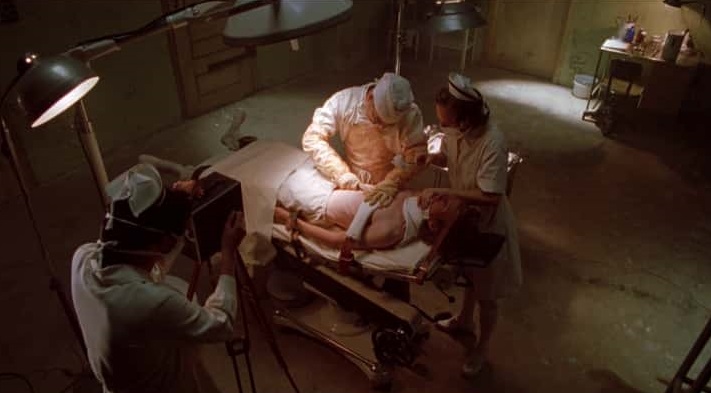Read More Breaking Marketing News
Maverick's Morning Thoughts
The Marketing System of the Evil Dr. Henry Cotton

It was like something out of a horror movie.
More specifically, like the film House on Haunted Hill with the evil villain Dr. Vannacutt who callously performed surgeries on mentally ill patients under his charge.
He did this in order to fulfill some sort of sick desire under the disguise of medical intervention, all while these torturous "medical procedures" were being celebrated.
Believe it or not, a story very similar to this occurred. And despite public outcry and a Senate investigation, only death could end the tenured reign of this evil monster: Dr. Henry Cotton.
Dr. Henry Cotton was born in Norfolk, VA on May 18, 1876. He studied in Europe under Emil Kraepelin and Alois Alzheimer (yes, he discovered Alzheimers), who were considered the pioneers of the day. He also was a student of Dr. Adolf Meyer of Johns Hopkins School of Medicine, who dominated American psychiatry in the early 1900s. He studied medicine at Johns Hopkins University and at University of Maryland.
After his medical studies, Dr. Cotton performed extreme surgical procedures such as tooth extractions, tonsillectomies, and removal of various internal organs, without solid scientific evidence supporting his methods.
Performing cruel and torturous procedures basically sums up the history of psychiatry; however, Dr. Cotton falsified his research, claiming his patients he so eagerly tortured were "cured" of their mental afflictions.
So much so that other prominent doctors began using his procedures as well, causing a chain reaction of pain and suffering in an already tormented world of the mentally infirmed.
His treatments resulted in a tragically high mortality rate, with reports suggesting that up to one in three patients died following his procedures.
Despite these alarming outcomes, Cotton continued to promote his methods as effective, using his position and persuasive marketing skills to maintain his reputation. This blatant disregard for patient welfare and the catastrophic consequences of his actions contribute to his legacy as a notorious figure in medical history.
The question is: how did his marketing system work that enabled him to allude the authorities, and even the US Senate for so long?
It all started in Trenton, NJ. Trenton Psychiatric Hospital was the first public mental hospital in the state of New Jersey.
At the time of its founding, on May 15, 1848, it was referred to as the New Jersey State Lunatic Asylum by Dorothea Dix, a nurse, and mental health activist.

...he expanded his surgical repertoire to include tonsillectomies, and eventually the removal of other organs like the stomach, ovaries, and colons.
Dr. Henry Cotton took charge of the Trenton Psychiatric Hospital in 1907.
He was a proponent of the theory that mental illnesses were caused by chronic infections.
While we now know that infections can cause a broad spectrum of psychiatric symptoms, e.g. delirium, psychotic disorder or mood disorder, Cotton's initial focus was on dental infections, leading him to remove teeth from patients.
When this didn't yield the desired results, he expanded his surgical repertoire to include tonsillectomies, and eventually the removal of other organs like the stomach, ovaries, and colons. Cotton's own sons were victims of his narcissistic delusions; he removed all of their teeth. Both eventually committed suicide.
Cotton claimed an astounding 85% cure rate, which brought him significant acclaim in the medical community across America and Europe.
Cotton's skillful marketing and public relations efforts played a significant role in his acceptance and fame.
His approach was rooted in the prevalent medical theories of the time, which did not yet benefit from the rigors of modern scientific methods.
This, combined with the lack of antibiotics, made surgeries quite risky. Despite this, Cotton's methods were hailed as revolutionary, and he received widespread praise from the scientific community and media.
His techniques were seen as the state of the art in medicine, as evidenced by positive reviews in publications like The New York Times.
The Times wrote this in 1922:
At the State Hospital at Trenton, N.J., under the brilliant leadership of the medical director, Dr. Henry A. Cotton, there is on foot the most searching, aggressive, and profound scientific investigation that has yet been made of the whole field of mental and nervous disorders... there is hope, high hope... for the future.
Despite the high death rates, his methods continued to be in demand.
The mortality rate was as high as 30%, and later evidence suggested it could have been closer to 45%.
Yet, Cotton's marketing prowess and the backing of influential figures in the psychiatric community helped shield his work from scrutiny for a significant period.
It wasn't until Dr. Phyllis Greenacre conducted an investigation in 1924 that significant doubts about Cotton's work began to surface.
Her findings pointed to chaotic hospital records, contradictory data, and a significantly lower success rate than Cotton had claimed.
Despite this, Cotton's influence and the support he garnered from the medical community and media allowed him to continue his practices for some time. It was only in the 1930s that his methods began to face serious professional debate and scrutiny, but even then, his practices continued at the hospital until his death from natural causes in 1933.
Dr. Henry Cotton's tyrannical and manipulative reign in Trenton, NJ was a tragedy, reflecting a concerning pattern in how deceptive marketing tactics are still exploited for harmful purposes today.
We often see leaders who use their charm and persuasive skills for unethical purposes. Dr. Cotton's manipulative tactics are similar to those of Dr. Paolo Macchiarini, a once-revered surgeon whose career was ruined by scandal and criminal actions. They both created a false image of being highly credible to hide the real flaws in their work.
This pattern isn't limited to medicine. Elizabeth Holmes and her company Theranos promised to transform blood testing with just a few drops of blood. She claimed her technology was groundbreaking, but investigations later revealed that it didn’t work as she had promised.
In the world of finance, Bernie Madoff's Ponzi scheme is another example of using the allure of 'cutting-edge' to deceive. He attracted investors with promises of high returns based on an 'innovative' investment strategy.
Like Cotton, Macchiarini, and Holmes, Madoff's claims helped him draw in and keep investors while avoiding close examination of his methods.
Dr. Cotton's case is a stark reminder of how marketing and public relations can create an illusion of success and credibility, even when the real practices are unethical and scientifically unsound.
We can learn from these instances to be wary of claims of revolutionary breakthroughs, especially when they are used to cover up unethical behavior under the guise of progress and corporate secrecy.
To your success!

DOMINATE and WIN with MAVERICK
Learn how to use marketing to get whatever you want.